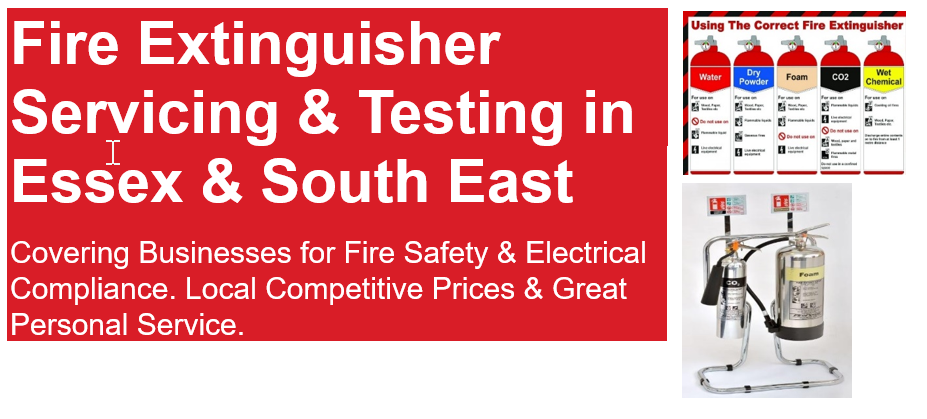
Fire Extinguisher Servicing and Fire Extinguisher Maintenance to BS5306 (Annual Service Contract)
Our service contract and annual maintenance visit, includes small items, such as pins and tags. Unlike many companies, we charge for the service visit and don’t rip you off on the extras! We always give you a cost for additional units or parts prior to any work. Our BAFE engineers come to your premises at a convenient agreed time to suit you, at the most competitive price.
Fixed Prices starting at only £44.95 for up to 5 units. No additional charges!
It is vital fire extinguishers are regularly serviced and properly maintained to ensure that they remain safe, function correctly and don’t let you down in event that you ever need to use them. By making sure that any extinguishers at your business are regularly serviced and maintained, you can be assured that they will function securely and effectively if used.
Basildon Fire Extinguishers, BAFE trained engineers, offer expert Fire Extinguisher Servicing and Maintenance contracts in and around Basildon and the Essex area, with prices that start at only £4.95 and include small service parts. We are specialists in a wide variety of equipment such as water, foam, CO2, powder and wet chemical extinguishers, so why not get in touch to discuss your requirements today?
Our Fire Extinguisher Checks
To make sure that your fire extinguisher is safe and well maintained, we will carry out the following checks:
- Ensure that nothing is blocking access to the equipment
- Check that it is correctly pressurised
- Ensure the individual parts, for example the nozzle, aren’t being affected by anything
- Make sure the pin and tamper seal are intact
- Check for general wear or neglect
- For extra peace of mind we offer a 24 hour emergency call-out service included in the cost of your contract, and provide replacement extinguishers (replacement charge extra).
Our Engineers
As well as guaranteeing that all of our services are to BS5306 standard, we pride ourselves on employing only BAFE (British Approvals for Fire Equipment) trained engineers. On our visit to service your equipment our engineers will label your extinguishers with the date of service and provide a certificate for insurance company purposes.
With a EMS engineer, we guarantee that:
- Fire extinguisher installation and service work is undertaken to the highest standards
- All extinguishers carry a British Standard Kitemark
- There is a five-year warranty with all new equipment
- Installation and service work can be undertaken promptly
- You will receive value for your money
- Free survey and quote without obligation
To find out more call head office on 01375 373934
Additional Services
As well as guaranteeing that all of our services are to BS5306 standard, we pride ourselves on employing only BAFE (British Approvals for Fire Equipment) trained engineers. On our visit to service your equipment our engineers will label your extinguishers with the date of service and provide a certificate for insurance company purposes.
With a EMS engineer, we guarantee that:
- Fire extinguisher installation and service work is undertaken to the highest standards
- All extinguishers carry a British Standard Kitemark
- There is a five-year warranty with all new equipment
- Installation and service work can be undertaken promptly
- You will receive value for your money
- Free survey and quote without obligation
To find out more call head office on 01375 373934
Along with service contracts, SAFE I.S. provides the following extras:
- New extinguishers, recharges, refills and seals
- Relevant signage
- Fire blankets
- Extinguisher storage cabinets
- Brackets
Call us now on 01375 373934
or Email us at sales@emssecurity.co.uk
Why not save time and more importantly money by having all your fire safety and pat testing taken care of in one package?
Fire Risk Assessments, Emergency Lighting Service, Fire Extinguisher annual Service, Security Systems and Electrical Pat Compliance Testing.
Call us now, we can quote you in less than 2 mins or send us an email. We are confident we can match any like for like quote, saving you money, whilst offering you a great service.
Fire Extinguisher Classification Codes (BS EN 3)
 The UK recognises six fire classes under the EN 3 regulations:
The UK recognises six fire classes under the EN 3 regulations:
- Class A fires involve organic solids such as paper and wood.
- Class B fires involve flammable or combustible liquids, including petrol, grease, and oil.
- Class C fires involve flammable gases.
- Class D fires involve combustible metals.
- Class E fires involve electrical equipment/appliances* (discontinued – see note below)
- Class F fires involve cooking fat and oil.
*Class E has been discontinued, but covered fires involving electrical appliances. This is no longer used on the basis that, when the power supply is turned off, an electrical fire can fall into any of the remaining five categories. However there is an additional feature requiring special testing (35 kV dielectric test per EN 3-7:2004). A powder or CO2 extinguisher will bear an electrical pictogram as standard signifying that it can be used on live electrical fires (given the symbol E). If a water-based extinguisher has passed the 35 kV test it will also bear the same electrical pictogram – however, any water-based extinguisher is only recommended for inadvertent use on electrical fires.

